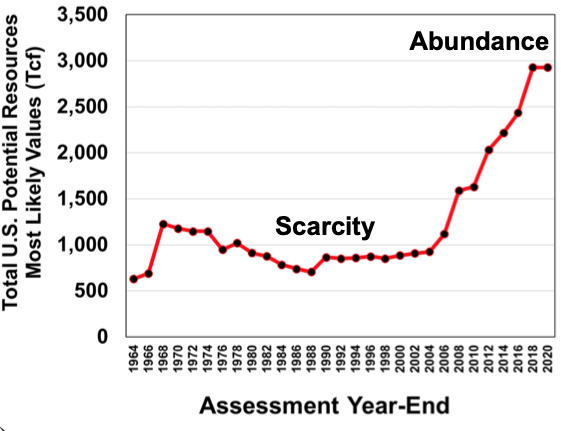 by James C. Sherlock
by James C. Sherlock
God looks after the United States of America. The fracking revolution tripled our recoverable natural gas volumes. America is the world king of natural gas.
In 2008, the wellhead price of natural gas reached $8 per thousand cubic feet in the United States. By 2012, it was $2.66. It fueled a new, cleaner industrial revolution.
God also smiles on Virginia. He put a huge percentage — nearly half — of America’s natural gas close to us.
But He also gave us too many lawyers, too many green-funding billionaires and the 4th U.S. Circuit Court of Appeals.
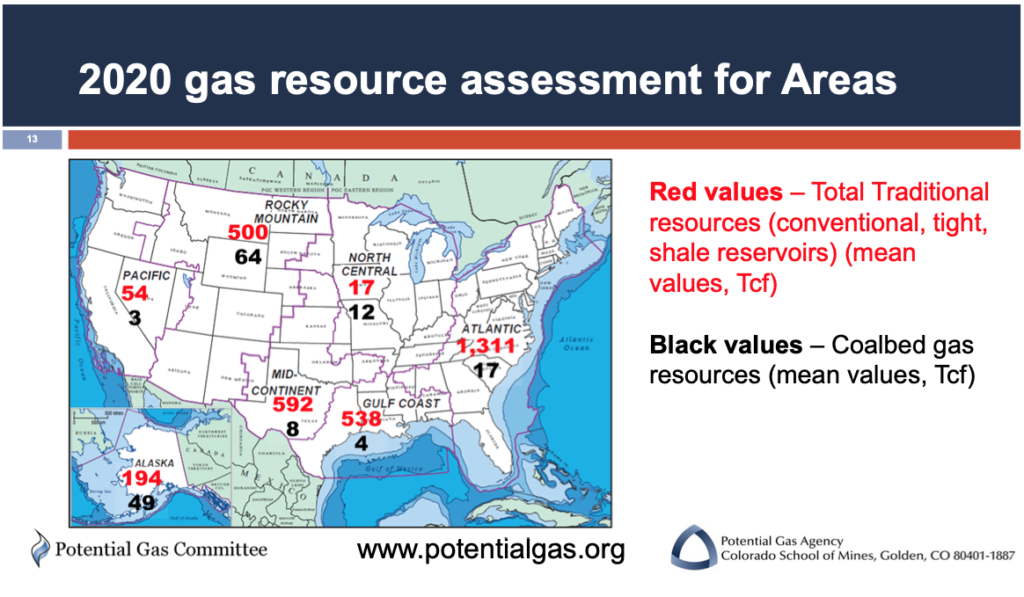
American producers have done the work to make natural gas available at the Appalachian wellhead.
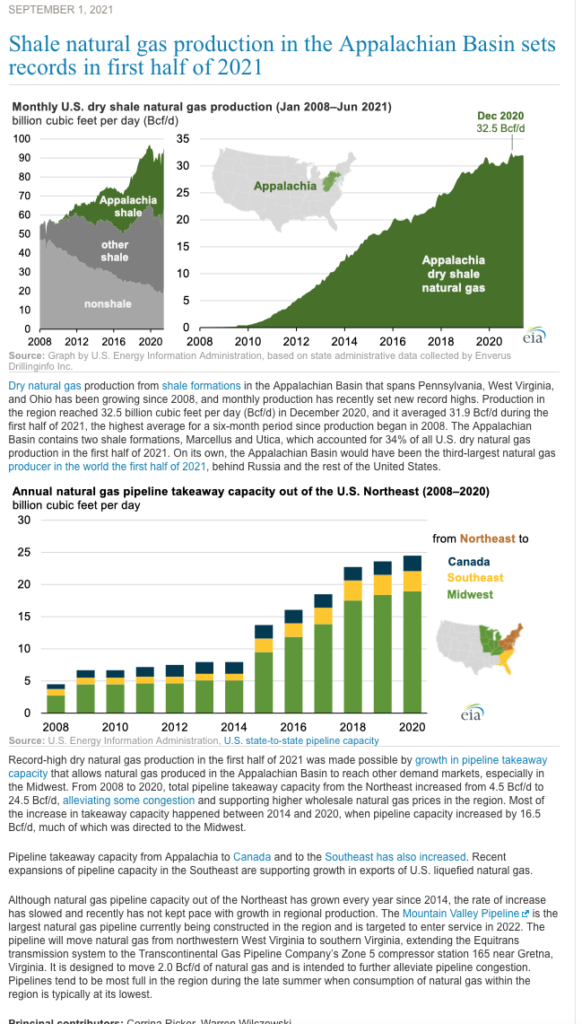
(Well, the Mountain Valley Pipeline [MVP] will now not be ready in 2022).
Yet the Consumer Price Index reported that natural gas prices were up nearly 50% year-over-year in December. In the past year, the wellhead price has varied from $8.56 to over $12. It is $12.34 today. So how can that be?
The answers, of course, are demand, storage and transportation. On the demand side, the U.S. Energy Information Administration reported in November of 2020:
The growing trend toward more natural gas-fired electricity generation generally encourages more storage capacity. This trend continued in 2020, and July 2020 holds the record for the most natural gas consumed in the electric power sector in a single month. Natural gas remains an important fuel to support the growing use of renewable energy-sourced operations such as wind and solar power.
The vast increases in the production of natural gas allowed the conversion of coal-fired electrical plants to much cleaner gas. Military installations made the same shift. Natural gas supports renewables. Do the greens know that? Does the 4th Circuit Court of Appeals in Richmond? Who do they think uses the gas? Or do they care?
Underground storage has physical limits. Pipelines are required to move the gas from where it is to where it is needed. The service areas for the Atlantic Coast and Mountain Valley pipelines are shown below. Virginia was the destination for both.
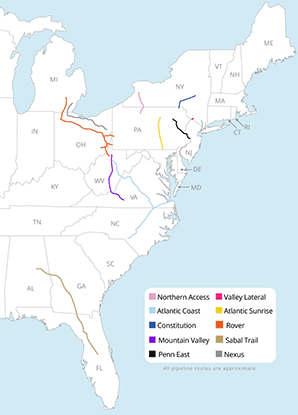
The underground Atlantic Coast pipeline was designed to transport natural gas supplies from West Virginia to public utilities in Virginia and North Carolina to generate cleaner electricity, heat homes, and power local businesses and the DoD installations in Hampton Roads. It has been cancelled.
From the Virginia Mercury:
Dominion attributed the (Atlantic Coast) pipeline’s demise to “ongoing delays and increasing cost uncertainty which threaten the economic viability of the project.” In particular, the utility pointed a finger at a string of legal challenges to federal and state permits the pipeline had received and then subsequently saw yanked. The delays had been extremely costly: since the initial $4.5 to $5 billion estimate, the price tag had risen to $8 billion.
In the end, the Supreme Court ruled in favor of Dominion and its partners in overturning a 4th Circuit decision but the lawsuits were still coming. Here is Dominion CEO Thomas Ferrell:
To state the obvious, permitting for investment in gas transmission and storage has become increasingly litigious, uncertain and costly.
This trend, though deeply concerning for our country’s economic growth and energy security, is a new reality.
The MVP received the required FERC Certificate of Convenience and Necessity on October 13, 2017, and construction activities began in early 2018. An estimated 20 linear miles of pipe remain to be completed. MVP’s total project work is nearly 94% complete, which includes 55.8% of the right-of-way fully restored – the details of which are shown on the adjacent map.
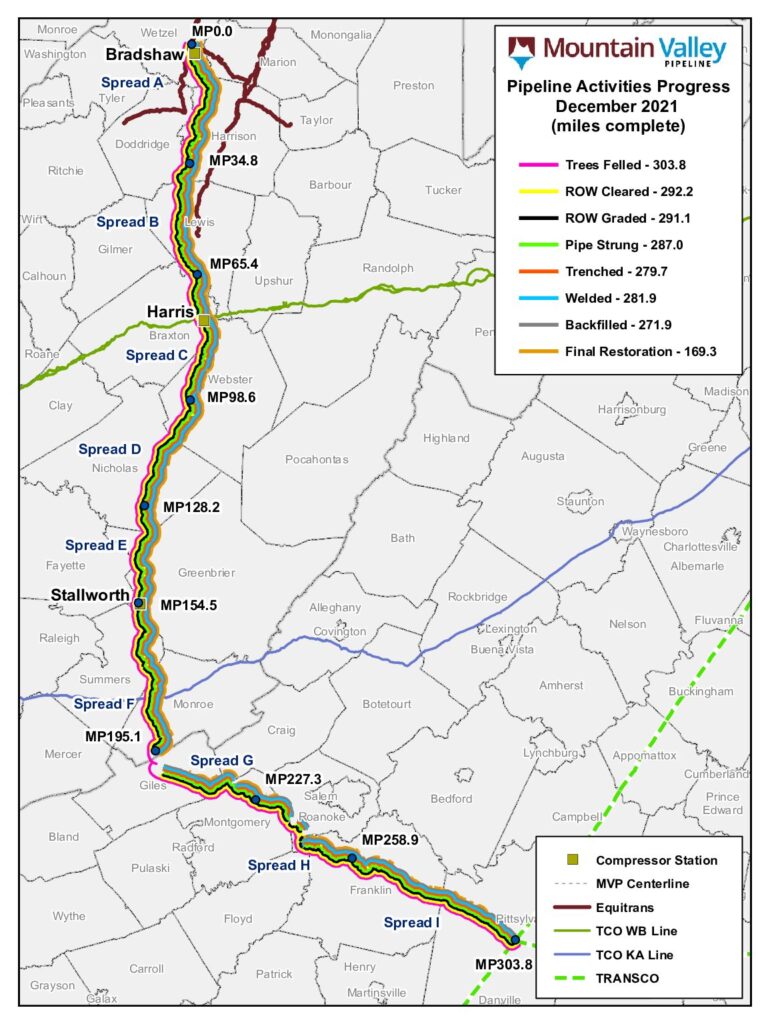
With the current course of events, the MVP is likely to be cancelled for the same reasons as the Atlantic Coast Pipeline. Government agencies must again rewrite permits for the Mountain Valley Pipeline to satisfy the Fourth Circuit — which has been perhaps the biggest challenge for developers since they first announced the project nearly a decade ago. The expense of the court battles and delays may prove too much for the investors.
The pipelines repeatedly passed required reviews by the federal agencies charged with environmental reviews. But the 4th Circuit has repeatedly overruled those agencies. That court has its own unique interpretation of the Endangered Species Act. Few projects will meet its standards. It puts the regional prospects for the new infrastructure bill in doubt.
The 4th Circuit as currently configured is an obstacle until the Supreme Court overturns some of its most “imaginative” decisions.
I expect that to happen at some point on the MVP, but we will have to see if that is enough to restart the project.
Now there is war in Europe.
Our European allies desperately need to replace Russian gas and we need to help them do so to preserve NATO. The Appalachians contain near limitless supplies of it. Hampton Roads is the closest major port to the Appalachian supplies.
The top four natural gas producing nations in the world were, in order (2018):
| Rank | Country | Continent | Annual NG production (million m 3) |
| 1 | United States | North America | 831,800 |
| 2 | Russia | Europe | 669,500 |
| 3 | Iran | Asia | 239,500 |
| 4 | Canada | North America | 184,700 |
Look at that list and see if it raises any issues.
High natural gas prices, shortages in Hampton Roads (including at its military bases), allies in need, geopolitical balance of power, plentiful supplies nearby, pipelines near completion, and the option of a new LNG terminal in the Port of Virginia.
The federal legislation writes itself. We need a bill to approve the Atlantic Coast and Mountain Valley pipelines directly as a national security matter to preempt any more lawsuits to block them.
We therefore need to find out the positions on that issue of Virginia’s two Senators and eleven Representatives and their opponents in the fall election.
Perhaps the press will ask.


